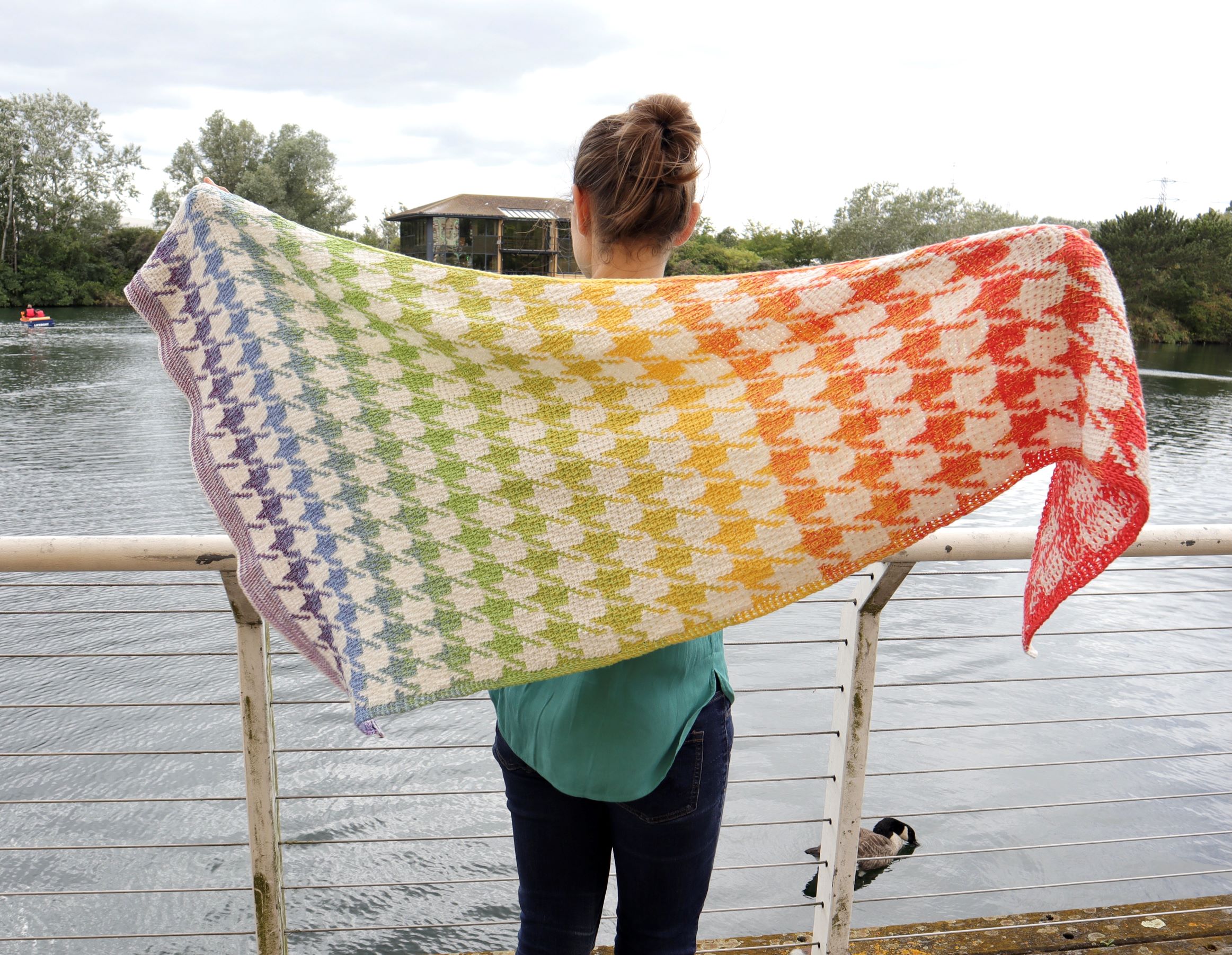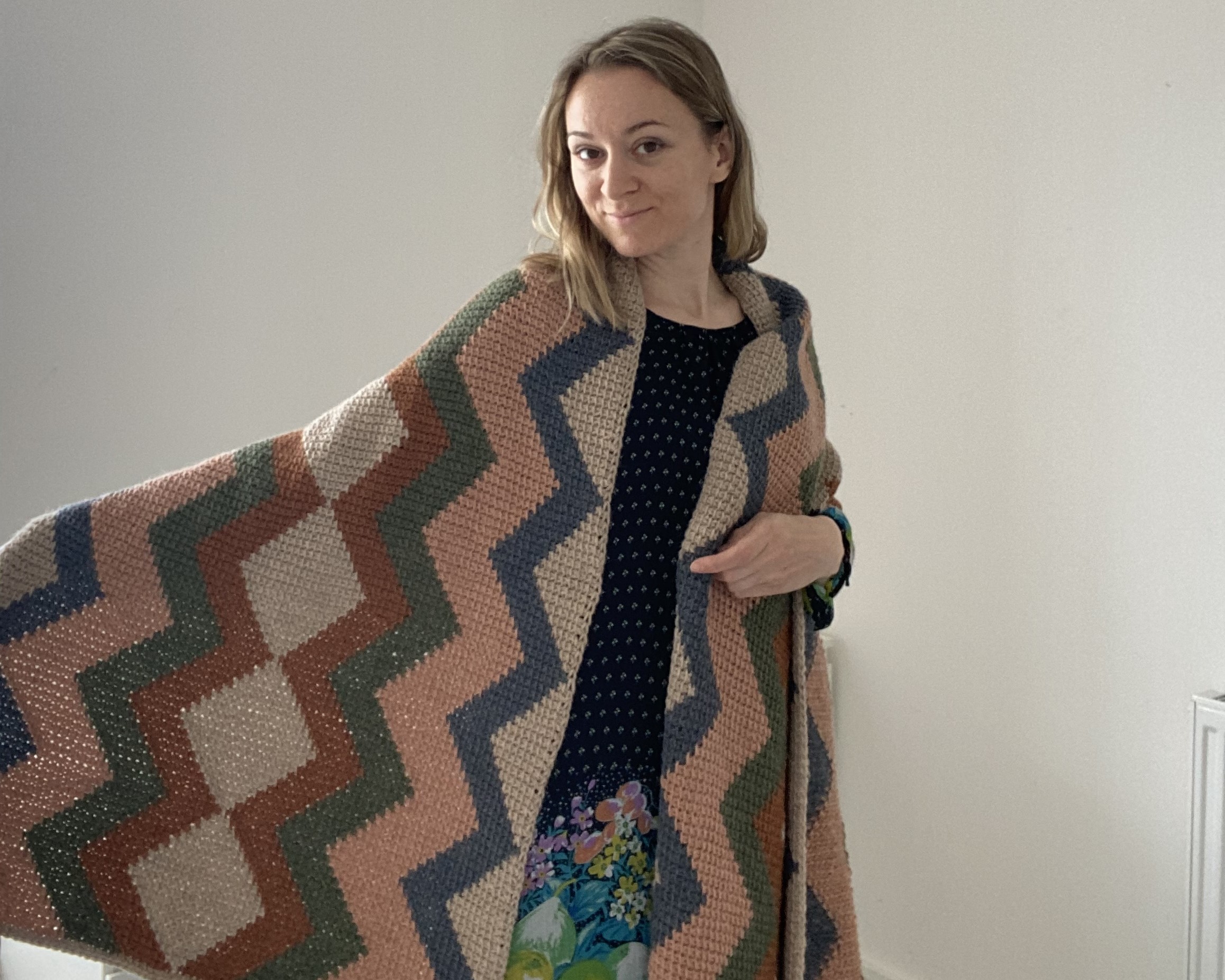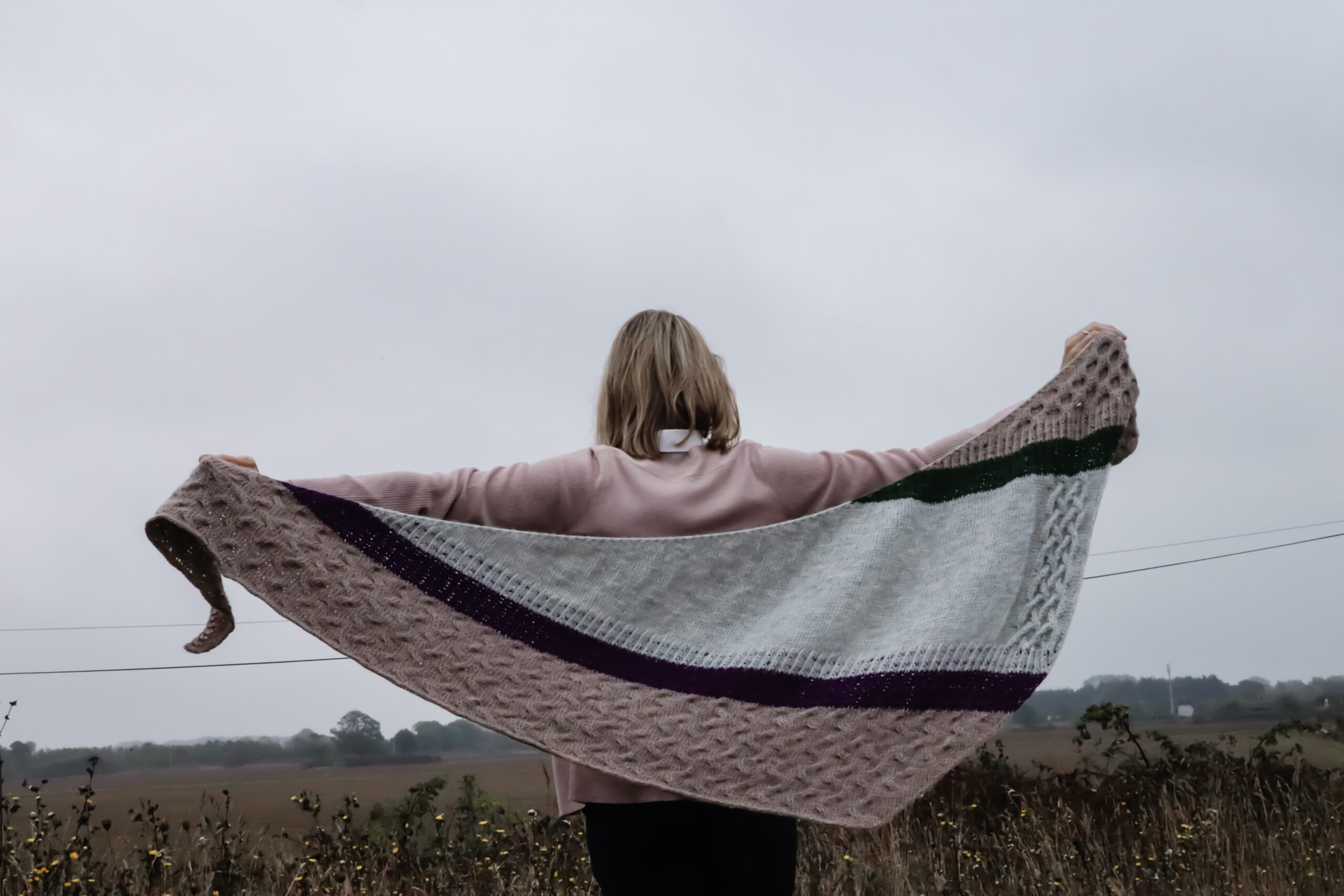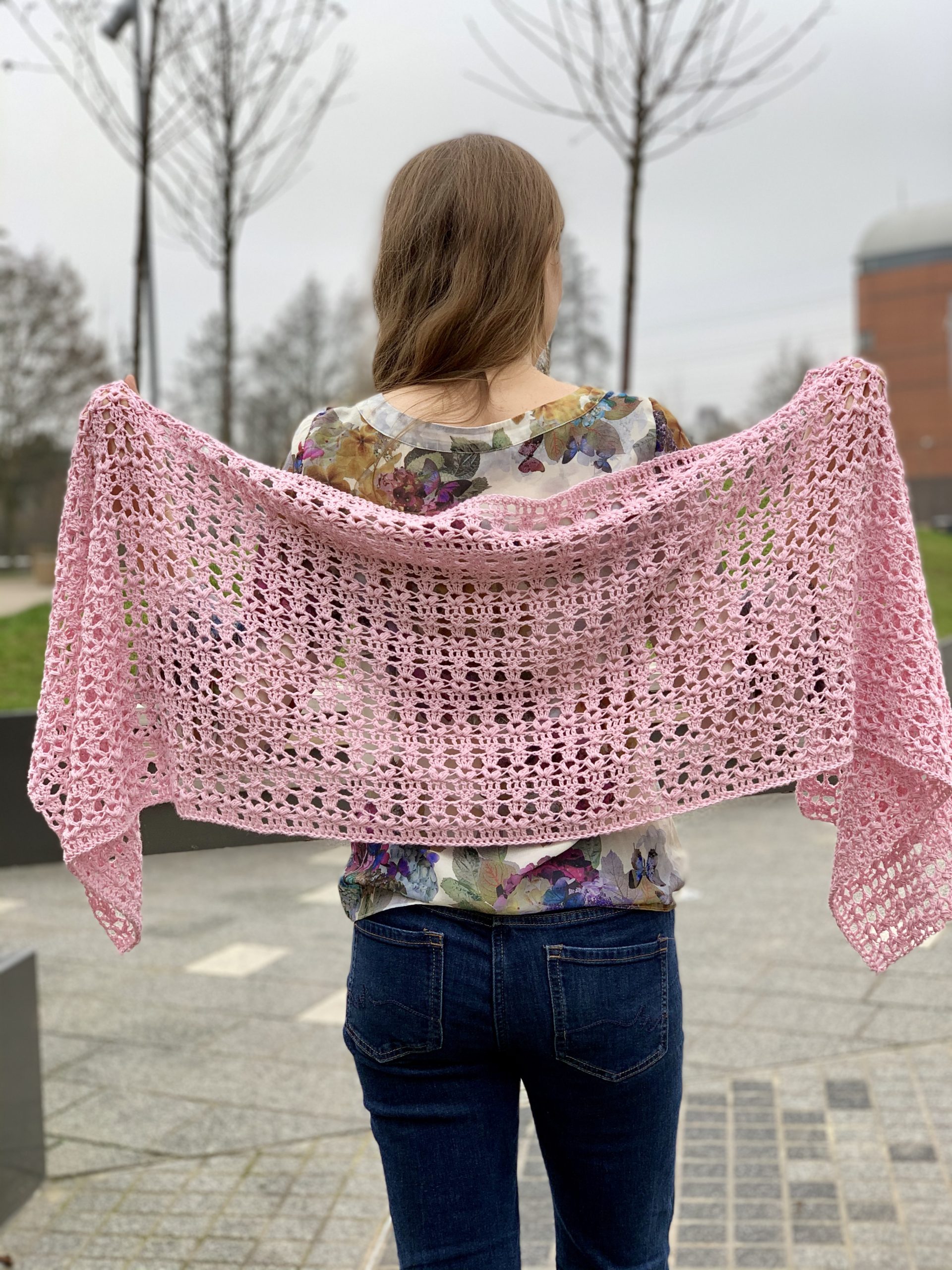Mannequin Shawl is a large Tunisian crochet triangular shawl that is constructed from the tip to the widest section by increasing 1 stitch every row. It uses up to 400 g of fingering yarn weight, which enables the shawl to be a great layering option and provides warmth on cold spring and autumn mornings.
The pattern uses basic Tunisian crochet stitches and simple yet very effective colourwork technique, which allows you to deal with loose floats on the back of your project without much fuss.
The sample is made in beautiful colours transitioning from red all the way to purple and contrasting white colour, however this classic fabric pattern would look stunning in 2 neutral colours too.
You can purchase the add free PDF version of the pattern at LoveCrafts here and Raverly here.
This site contains affiliate links to products. We may receive a commission for purchases made through these links at no extra cost to you. This helps to cover the running cost of the website and enables me to continue making free patterns.
Please NOTE that this pattern is subject to copyright and is my intellectual property. The online version is for personal use only. Do not re-publish or sell this pattern in part or full, or make video tutorials of it. Any such actions are a breach of copyright and can result in legal action.

Skills required
Chain, Tunisian crochet technique (alternating forward and return passes), Tunisian simple stitch (tss), Tunisian knit stitch (tks), increasing under front horizontal bar (inc A), Return pass changing colours, stranded colourwork, Tunisian simple stitch bind-off, blocking.
Skill level

Finished measurements
The final shawl measurements (blocked):
102 x 160 x 190.5 cm (approx. 40 x 63 x 75 in)
Materials and tools
Crochet UK (50% Cotton, 50% Acrylic | Fingering | 200 g (7 oz) = 750 m (820 yds)), White (#310) (A) 1 cake, Newcastle (B) 1 cake

You can get your yarn cake here.
Tunisian crochet hook size 4.5 mm (US size 7) with cable (at least 60 cm (24 in)) or size to obtain the gauge
Tapestry needle
Scissors
You can get your craft supplies here.
Gauge
Blocked Gauge:
22 sts x 14 rows = 10 x 10 cm (4 x 4 in) over tss st pattern
Gauge helps you to understand how the project turns out in terms of the final size. If you would like to achieve the exact size of the final project as in the instructions above, you gauge needs to match exactly to the above.
If you get more stitches and/or rows than stated above using the exact hook size as per instructions, your final project will turn out smaller. Conversely, if you get less stitches and/or rows than stated above using the exact hooks size as per instructions, your final project will turn out bigger.
To make adjustments, if you get more stitches and/or rows, you can try using bigger hook size to get closer to the desired size. Conversely, if you get less stitches and/or rows, you can try using smaller hook size to get closer to the desired size.
It may take trial and error to try out a few hook sizes to achieve the exact size.
Alternatively, if you really don’t want to make several samples to achieve the desired size, you can try to alter your tension as you work the project. However, I would advise to try this out once you master the basics of Tunisian crochet as it may be a bit tiresome to try to master the basics of Tunisian crochet and focus on alternating your tension while working the project.

Stitch guide
Tunisian crochet stitches are worked in 2 steps; forward and return pass from right to left, with the number of sts (lps) increasing on the hook during the forward pass and decreasing during the return pass.
Return pass is worked in the same way for all stitches (rows of sts) used in this project as follows (EXCEPT when changing colours on return pass, please see below for details of this technique): 1 ch, *yrh, draw through 2 lps on hook, rep from * until 1 lp on hook.
Return pass changing colours in Tunisian crochet: The new colour is added when starting the return pass of the row and all lps of the forward pass are on the hook (i.e. End stitch was worked). Yrh with the old colour from front to back (this adds an extra loop on hook to create neat edge that matches the edge created during Standard RP). Add new colour on hook: draw through 2 lps, * yrh, draw through 2 lps on hook; rep from * until 1 lp on hook.
Edge stitches:
Right edge stitch– This is the first lp on hook and counts as first st unless otherwise stated.
Left edge stitch– This st is referred to in the pattern as the End Stitch (ES) and is crocheted as follows: Rotate the end of the fabric towards yourself, insert the hook under both bars (left and right) of the last st, yrh and pul.
- First row of Tunisian crochet: Insert the hook in the back bump of second ch from hook, yrh and pul across.
- Tunisian simple stitch: Insert the hook from right to left under front vertical bar of the next st, yrh and pul.
- Tunisian knit stitch: Insert the hook from front to back between the front and back vertical bar, yrh and pul.
Increase under front horizontal bar: Insert the hook from front to back under front horizontal bar, yrh and pul (1 st increased).
Stranded colourwork: The basic principle for the colourwork is to trap long loose floats created during FP and RP of a particular row on FP of the consecutive row.
It is most useful and efficient to trap the floats after every 3 stitches. For example, if the strand(s) of yarn is (are) carried over 6 stitches, the float would be trapped on stitch 3 and 4. Trapping floats more often can result in very neat looking WS of the project but it adds a lot of extra work, while trapping floats less often leaves floats that are likely to caught on jewellery, fingers of whatever comes their way. This is however only my observation, and you may test the method to come up with your own stitch interval.
The process of trapping loose floats is carried out in 2 steps as follows:
- Work tss as per pattern instructions, while inserting the hook under both floats of the previous row (1 created during FP and 1 created during RP), yrh and pul. (Appendix: Pic 1)
- Work tss as per pattern instructions, while inserting the hook over both floats of the previous row (1 created during FP and 1 created during RP), yrh and pul. (Appendix: Pic 2)
Repeat these 2 steps as needed at regular stitch intervals.
Tunisian Simple stitch bind off: Insert hook from right to left under front vertical bar of the next st, yrh, pul and pull through the lp that is on the hook. One lp remains on the hook.
If this is your first Tunisian crochet project or your need a little refresher on the basics of Tunisian crochet, I have a Tunisian crochet basics masterclass that would be a lovely introduction to build your skills on:
| Abbreviations: | |
| ch- chain | yrh- yarn round the hook |
| st(s)- stitch(es) | pul- pull up a loop |
| lp(s)- loop(s) | FP- forward pass |
| tss- Tunisian simple stitch | RP- return pass |
| RS- right side | approx.- approximately |
| WS- wrong side | rep- repeat |
| tks- Tunisian knit stitch | inc A- increase under front horizontal bar |
| ES- end stitch |
Stitch chart
Houndstooth Stitch Chart:

Notes
- The Mannequin Shawl is worked flat RS facing from bottom up.
- The shawl starts at a tip and grows gradually by 1 st per row.
- The stitch count refers to the number of lps on hook on FP.

Instructions
With A chain 3.
Row 1 FP: Insert the hook in the back bump of second ch from hook, yrh and pul, insert the hook in the back bump of next ch from hook, yrh and pul. 3 lps on hook.
Row 1 RP and all other RPs: Standard RP.
Row 2: Tks in next st, inc A, ES. 4 lps on hook.
Row 3: Tks in next 2 sts, inc A, ES. 5 lps on hook.
Row 4: Tks in next 2 sts, inc A, tks in next st, ES. 6 lps on hook.
Row 5: Tks in next 2 sts, inc A, tks in next 2 sts, ES. 7 lps on hook.
Row 6 FP: Tks in next 2 sts, inc A, tss in next st, tks in next 2 sts, ES. 8 lps on hook.
Row 6 RP: Change colour to B, Standard RP.
Row 7 FP: Tks in next 2 sts, inc A, tss in next 2 sts, tks in next 2 sts, ES. 9 lps on hook.
Row 7 RP: Change colour to A, Standard RP.
Row 8 FP: Tks in next 2 sts, inc A, tss to last 3 sts, tks in next 2 sts, ES. 10 lps on hook.
Row 8 RP: Change colour to B, Standard RP.
Row 9 FP: Rep Row 8. 11 lps on hook.
Row 9 RP: Change colour to A, Standard RP.
Row 10 FP: Rep Row 8. 12 lps on hook.
Row 10 RP: Change colour to B, Standard RP.
Rows 11-15: With colour B, Rep Row 8. 17 lps on hook.
Row 16: Tks in next 2 sts, inc A, work Houndstooth Colour Chart to last 3 sts, tks in next 2 sts, ES. 18 lps on hook.
Rows 17-26: Tks in next 2 sts, inc A, continue working Houndstooth Colour Chart as commenced in Row 16, tks in next 2 sts, ES. 28 lps on hook.
Rows 27-213: Rep Rows 16-26 17 times. 215 lps on hook.
Row 214 FP. Rep Row 8. 216 lps on hook.
Row 214 RP: Change colour to A, Standard RP.
Row 215 FP. Rep Row 8. 217 lps on hook.
Row 215 RP: Change colour to B, Standard RP.
Row 216 FP. Rep Row 8. 218 lps on hook.
Row 216 RP: Change colour to A, Standard RP.
Row 217 FP. Rep Row 8. 219 lps on hook.
Row 217 RP: Change colour to B, Standard RP.
Row 218 FP. Rep Row 8. 220 lps on hook.
Row 218 RP: Change colour to A, Standard RP.
Row 219: Tunisian Simple stitch bind-off.
Finishing
Weave in ends and block to final measurements.
I would love to see and share your work on social media, use #mannequinshawl or #exquisitecrochetuk.
Pattern support: exquisite.crochet.uk@gmail.com
Further resources:
Pattern video tutorial:
Appendix
Stranded colourwork
This is how the WS of your project will look like:

Step 1 of colourwork (refer to Stitch guide for full instructions):

Step 2 of colourwork (refer to Stitch guide for full instructions):

Colour chart
Houndstooth Colour Chart

For endless crochet inspiration, you can subscribe to AllFreeCrochet website here.
If you prefer to have all your craft inspiration in one place, FaveCrafts is definitely the place to go. Why not subscribe to their newsletter here so you would not miss a thing!
Did you enjoy the Mannequin Shawl pattern? Why not try my other Shawl patterns:





Thank you so much if you got this far in the pattern! I hope you got inspired for your own version using various colours. I can’t wait to see it! Don’t forget to tag me on Instagram and let me know in the comment section below how you got on with it! As always, if you have any pattern query, the quickest way to get it answered is by emailing me on the pattern support email address above.
Happy crocheting!




